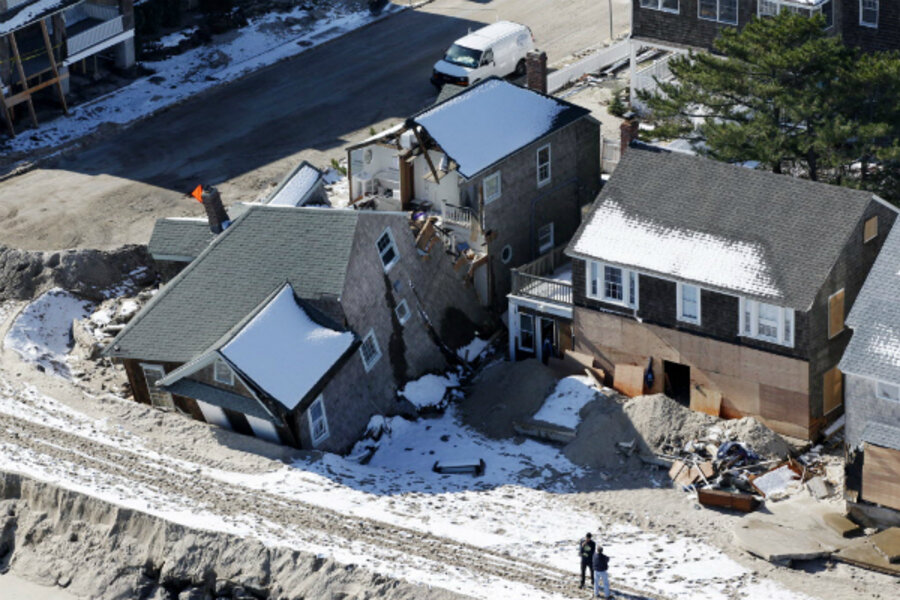Living in a flood zone? Check your insurance. It may be about to go up.
Loading...
If you live on a coastline or in a river flood plain, check your flood insurance and where your home or business sits on the latest federal flood maps.
As of Oct. 1, the final stages of a 2012 flood-insurance reform law kick in, aimed at substantially reducing subsidies for federal flood insurance.
Premiums charged to most once-subsidized policyholders are slated to rise over the next four years, until the premiums reach the rate that reflects the true flood risk their properties face.
The Federal Emergency Management Agency (FEMA), which oversees the National Flood Insurance Program, began to phase out subsidies in January for policies on homes that aren't a policyholder's primary residence.
In October, subsidies will vanish for a range of other properties – from businesses and multifamily homes subject to repeated flood damage to property where insurance claims over time have grown to exceed the fair-market value of the property.
Subsidized insurance will still be available for about 715,000 properties, mostly single-family homes, notes Ray Lehmann, a senior fellow at the R Street Institute, a libertarian think tank in Washington that supported the reforms. But once a home is sold, or more than half of it is rebuilt after experiencing flood damage, or when new homes are built in flood zones, the unsubsidized rates will kick in. Rates also would rise if new flood maps show an increased risk for an existing home once thought to be in a safe location.
The drivers for reform: a flood-insurance program that is nearly $30 billion in the red, taking in premiums of some $3.6 billion; continued development along US coastlines and in other flood-prone areas; and global warming's current and projected impact on rising sea levels and weather extremes.
"This is a very significant moment in our national Zeitgeist in terms of people starting to recognize that climate risks are affecting every part of our life, including our economic choices, where we live, where we do business," says Rachel Cleetus, a senior economist with the Union of Concerned Scientists' Climate and Energy Program.
The National Flood Insurance Program currently has 5.6 million policies on its books covering properties collectively worth more then $1.2 trillion, noted FEMA Administrator Craig Fugate, during a mid-September Senate hearing on implementation of the Biggert-Waters Flood Insurance Reform Act of 2012.
Of those 5.6 million policies, about 20 percent have been subsidized.
And while about 1.3 percent of the subsidized policies cover property that has experienced repeated bouts of flood damage, those properties have accounted for some 25 percent of the flood-insurance program's payouts since 1978, Dr. Cleetus says.
Subsidies for flood insurance long have been the bane of scientists and policy analysts who work on reducing risks to natural hazards. Over the years, they say, the subsidies on flood insurance have encouraged development in locations subject to repeated floods and storm surge.
But the Senate hearing on the issue earlier this month was driven in no small part by a rising chorus of complaints from constituents who say the premium increases have caught them by surprise. In addition, concerns have been raised about the ability of low-income residents to pay higher premiums.
Indeed, one scientist who has argued for flood-insurance reform nevertheless says that the current reforms offer "too much tough love and too little compassion for flood-prone homeowners."
In an opinion piece he published in The New York Times in late August, Nicholas Pinter, a geology professor at Southern Illinois University in Carbondale, conceded that "policy reform and fiscal discipline sound great until you sit across the table from flood-plain residents losing their homes because of skyrocketing insurance premiums."
Homeowners elsewhere have complained that the higher premiums that more closely reflect the risk a home faces from floods is undercutting the resale value of their homes.
Proposals to soften the blow range from stretching out the period over which premiums will increase to delaying the adoption of FEMA's new flood maps, which don't yet account for projected sea-level rise.
But to advocates of the reforms, these fixes don't address the flood-insurance program's financial woes. And they could lead to the wrong people paying higher premiums.
For instance, FEMA has noted that the new flood-hazard maps tend to result in just about as many properties seeing their flood hazard reduced as increased, notes Stephen Ellis, vice president of Taxpayers for Common Sense, a fiscal watchdog group in Washington. Delaying the application of the new maps would mean that those with a reduced risk would be overpaying for their flood insurance, he says, in an e-mail.
Meanwhile, FEMA is working with the National Academy of Science to explore ways to provide aid to low-income families, such as means-tested vouchers or low-interest loans to modify their homes in ways that reduce their flood-insurance premiums, notes Erwann Michel-Kerjan, an economist who focuses on risk management at the University of Pennsylvania's Wharton School of Business.
Whatever the outcome, the overhaul of flood insurance is a clear example "that people are waking up to potential liabilities the government faces" with a changing climate and the continued development in flood-prone areas, suggests William Hooke, director of the American Meteorological Society's Policy Program in Washington. "The past history with flood loss is not necessarily the future flood losses. The US could be taking on big risks it's unprepared for."








